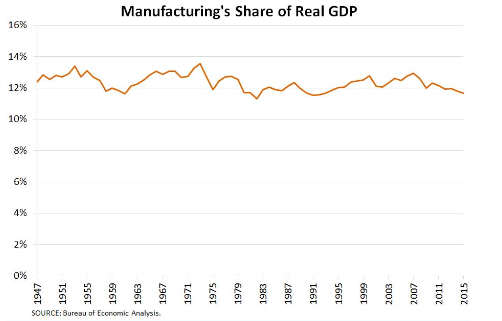U.S. manufacturing production rose to a very high level in 2017. Nonetheless, there is a popular narrative around, fed more by ignorance than understanding causation, that U.S. manufacturing has been on a precipitous decline.
Indeed, at first glance, the employment numbers seem to paint a bleak picture for the health of the manufacturing sector. But recognize that this popular misconception is caused more by focusing only on employment trends and ignoring real production growth.
Indeed, after holding roughly steady through the 1990s, the number of manufacturing jobs in the U.S. dropped from over 17 million in 2000 to 12.5 million as of the end of 2017. But the employment share of manufacturing has been declining even longer than that. About 32% of American workers held manufacturing jobs in 1953, but that share was down to just 8.4% in 2017.
(In terms of the manufacturing share of nominal GDP, it has also been declining. Manufacturing’s share of nominal gross domestic product (GDP) dropped from 28.1 percent in 1953 to just 11.5% as of Q3 of 2017.)
Nonetheless, by removing inflation from the GDP calculations, manufacturing share of real GDP in the U.S. has been roughly constant over the past 70 years.
That is, manufacturing’s share of real GDP has been fairly stable since the 1940s, ranging from 11.3% to 13.6%. The manufacturing share of real GDP was 11.7% in 2015. (See Federal Reserve Bank of St. Louis, Is U.S. Manufacturing Really Declining? April 11, 2017).
In sum, the following chart indicates that, over the past 70 years, the growth in real manufacturing output in the U.S. has kept up with growth in the rest of the economy.














Leave A Comment